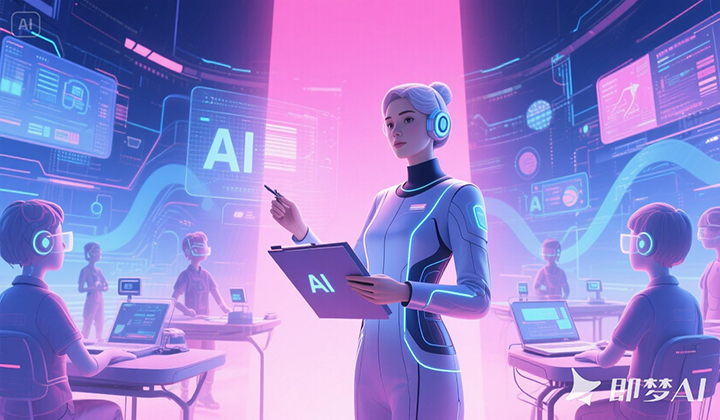The Convergence of AI and Communications: Reshaping the Future of Connectivity
观棋 2025-06-04
The integration of artificial intelligence (AI) into communications is revolutionizing how we connect, operate, and innovate. From optimizing network performance to enhancing security and enabling personalized services, AI is transforming every layer of the communication ecosystem. This article explores the transformative applications of AI in communications, its challenges, and the promising future it unlocks.
The Convergence of AI and Communications: Reshaping the Future of Connectivity
The integration of artificial intelligence (AI) into communications is revolutionizing how we connect, operate, and innovate. From optimizing network performance to enhancing security and enabling personalized services, AI is transforming every layer of the communication ecosystem. This article explores the transformative applications of AI in communications, its challenges, and the promising future it unlocks.
Companies like Huawei and Ericsson are leading the charge with self-optimizing networks. Huawei’s iMaster NCE uses AI to automate topology optimization, while Ericsson’s Self-Organizing Network (SON) reduces manual interventions by 80% and improves energy efficiency by 14% through predictive traffic modeling . Nokia’s Altiplano Access Controller, integrated with AIOps, detects anomalies faster and optimizes resource utilization, ensuring seamless operations for over 160 global broadband operators .
Ericsson’s Security Management Platform, for example, uses AI to monitor networks 24/7, cutting operational costs by 80% and improving incident response efficiency by 20% . Similarly, AI-driven anomaly detection tools like IsolationForest help identify irregularities in network traffic, ensuring proactive mitigation of potential breaches .
China Mobile’s white paper emphasizes how AI enhances traditional services like voice calls and messaging, introducing immersive technologies such as 3D video and digital twins . Meanwhile, edge computing platforms, like Nokia’s DAC, combine AI with private wireless networks to enable real-time analytics in industrial settings, optimizing productivity and worker safety .
Standardization efforts by organizations like 3GPP and ITU are pivotal. 3GPP’s Release 17 introduced AI-specific features for network optimization and energy efficiency, while ITU’s new standards on AI-driven code generation and large model frameworks provide a global roadmap . These initiatives ensure interoperability and ethical AI deployment across borders.
Additionally, ecosystem complexity demands collaboration among stakeholders. China Mobile’s white paper calls for industry-wide cooperation to address interoperability issues and build secure, scalable AI-communication ecosystems .
As AI continues to evolve, its role in communications will shift from optimization to autonomy, empowering networks to self-diagnose, self-heal, and anticipate user needs. This transformation will not only redefine connectivity but also unlock new business models and societal benefits.
In conclusion, AI is not just a tool for enhancing communications—it is a catalyst for reimagining the future of global connectivity. By addressing challenges collaboratively and embracing innovation, stakeholders can harness AI’s full potential to create smarter, safer, and more inclusive communication networks.
The integration of artificial intelligence (AI) into communications is revolutionizing how we connect, operate, and innovate. From optimizing network performance to enhancing security and enabling personalized services, AI is transforming every layer of the communication ecosystem. This article explores the transformative applications of AI in communications, its challenges, and the promising future it unlocks.
1. AI-Driven Network Optimization
AI is redefining network management by automating complex tasks and enabling predictive analytics. For instance, 中国移动’s AI + Communication Service White Paper highlights how AI enhances network efficiency through dynamic resource allocation and traffic prediction . By analyzing historical data with machine learning models like LSTM, networks can anticipate traffic patterns and adjust bandwidth allocation in real time, reducing latency and improving user experience .Companies like Huawei and Ericsson are leading the charge with self-optimizing networks. Huawei’s iMaster NCE uses AI to automate topology optimization, while Ericsson’s Self-Organizing Network (SON) reduces manual interventions by 80% and improves energy efficiency by 14% through predictive traffic modeling . Nokia’s Altiplano Access Controller, integrated with AIOps, detects anomalies faster and optimizes resource utilization, ensuring seamless operations for over 160 global broadband operators .
2. Enhanced Security with AI
As cyber threats grow sophisticated, AI is critical for robust defense. AI-powered firewalls, such as Tencent Cloud’s solution, employ deep learning to detect zero-day attacks and analyze encrypted traffic without decryption . These systems learn from vast datasets to identify malicious patterns, reducing false positives and strengthening real-time threat response.Ericsson’s Security Management Platform, for example, uses AI to monitor networks 24/7, cutting operational costs by 80% and improving incident response efficiency by 20% . Similarly, AI-driven anomaly detection tools like IsolationForest help identify irregularities in network traffic, ensuring proactive mitigation of potential breaches .
3. Intelligent Terminals and Personalized Services
AI is transforming communication devices into intelligent companions. Smartphones and wearables now leverage AI to learn user behaviors, enabling personalized experiences. For example, NVIDIA’s AI-driven customer service solutions, adopted by Thailand’s 7-Eleven, achieve 97% accuracy in Thai speech recognition, reducing call center workload by 60% .China Mobile’s white paper emphasizes how AI enhances traditional services like voice calls and messaging, introducing immersive technologies such as 3D video and digital twins . Meanwhile, edge computing platforms, like Nokia’s DAC, combine AI with private wireless networks to enable real-time analytics in industrial settings, optimizing productivity and worker safety .
4. The Rise of 6G and AI Synergy
The next generation of communications, 6G, will deeply integrate AI to achieve intelligence-native networks. At the 2025 Global 6G Summit, experts highlighted how AI will enable real-time decision-making, autonomous optimization, and seamless integration with emerging technologies like IoT and edge computing . However, challenges remain, such as aligning AI’s processing speed with 6G’s millisecond-level latency requirements.Standardization efforts by organizations like 3GPP and ITU are pivotal. 3GPP’s Release 17 introduced AI-specific features for network optimization and energy efficiency, while ITU’s new standards on AI-driven code generation and large model frameworks provide a global roadmap . These initiatives ensure interoperability and ethical AI deployment across borders.
5. Challenges and Ethical Considerations
Despite its promise, AI in communications faces hurdles. Data privacy is a critical concern, as AI relies on vast datasets that may include sensitive information. Solutions like data minimization, encryption, and compliance with regulations (e.g., GDPR) are essential . Real-time constraints, particularly in 6G, require AI models to operate at microsecond speeds, necessitating advancements in hardware and algorithm efficiency .Additionally, ecosystem complexity demands collaboration among stakeholders. China Mobile’s white paper calls for industry-wide cooperation to address interoperability issues and build secure, scalable AI-communication ecosystems .
6. Future Outlook
The symbiosis of AI and communications will drive unprecedented innovation. By 2031, the global communications AI market is projected to reach $38.8 billion, with 5G/6G integration fueling applications like autonomous vehicles, smart cities, and immersive entertainment . Companies like Ericsson are already developing Talk to Your Network (TTYN) frameworks, enabling natural language interaction with networks for proactive issue resolution .As AI continues to evolve, its role in communications will shift from optimization to autonomy, empowering networks to self-diagnose, self-heal, and anticipate user needs. This transformation will not only redefine connectivity but also unlock new business models and societal benefits.
In conclusion, AI is not just a tool for enhancing communications—it is a catalyst for reimagining the future of global connectivity. By addressing challenges collaboratively and embracing innovation, stakeholders can harness AI’s full potential to create smarter, safer, and more inclusive communication networks.












